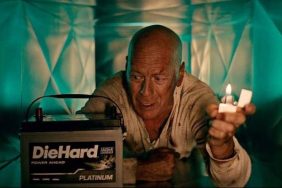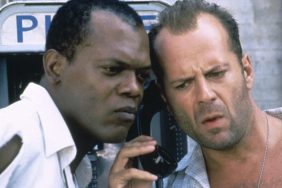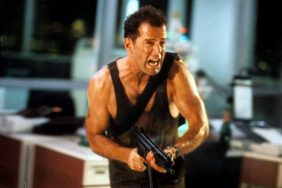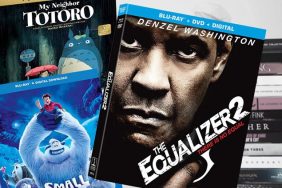Welcome back, cowboys, to The Series Project, where we’ll be talking about the two final chapters in the ever-growing Die Hard franchise; yes there are rumors of a sixth Die Hard on the horizon, but I’ll believe that when I see it. I think that we’re finished with A Good Day to Die Hard, and I can come to some definite conclusions about the series at large, and about the character John McClane in particular.
Thanks to the 25th Anniversay Blu-ray set, so generously provided to CraveOnline, I could see all the Die Hard films to date. I also went to a screening this week, so I’m up to all five.
To catch you up from last week’s article, I covered one of the best action flicks ever made (Die Hard), a pretty mediocre one with some spectacular effects (Die Hard 2), and a huge and boldly entertaining flick that gleefully goes way over the top (Die Hard with a Vengeance). And for many years, most fans assumed that the franchise would conclude there. Three parts, eight years, and goodnight. But by the time the mid ’00s rolled around, and the remake machine was proving to be cheap and profitable (insert list of films that were remade from 2003 to 2009), several moribund franchises (in addition to Die Hard) were also being hauled out of mothballs to bank in on the nostalgia dollar. To digress slightly: I’m surely not the first critic to make the observation that we seem to be living in a largely fallow time for Hollywood filmmaking. The vast bulk of mainstream films to hit theaters these days seem to be sequels, remakes, or based on an already well-known and bankable property. Producers won’t finance anything unless it has “marquee value.” As such, I felt that films like Rocky Balboa or Indiana Jones and the Kingdom of the Crystal Skull or even Live Free or Die Hard were largely cynical enterprises, and not really intended to take each series to its respective logical conclusion. So Die Hard 4.0 (as it was originally called) was extraneous by design. There was no need to continue the franchise that had already, in the minds of the public, concluded entirely.
But, lo and behold, 12 full years after the last flick, we had to contend with another sequel. No one was asking for it. In a way, this was the exact wrong time for a Die Hard film, not just because there was no demand, but something had changed in the world. No least of which was the world’s view of terrorism. In fact, instead of continuing to ramble in this introduction, why don’t we leap immediately into…
Live Free or Die Hard (dir. Len Wiseman, 2007)

“Live Free or Die” is the state motto of New Hampshire, and can be seen on that state’s license plates. Live Free or Die Hard does not take place in New Hampshire, but mostly in Washington DC, with pitstops in New Jersey, West Virginia, and Virginia. I take exception to this.
I’ll say up front that Live Free or Die Hard isn’t a bad film. Surely, it’s competent and slick, and has some really awesome action sequences including a scene where John McClane (Bruce Willis) drives a police car up a ramp, and leaps out at the last second, causing the unmanned catapulted car to collide with a helicopter midair. There’s also a pretty spectacular action sequence near the end with an empty multi-level freeway collapsing around McClane’s truck, while a bad guy’s Harrier jet shoots at him. These sequences are pretty over-the-top, and they make Live Free or Die Hard a mildly entertaining flick, but they lack the clunky panache of the previous film, and could, to be perfectly honest, be placed into just about any action film of the last 15 years with little tonal change. The whole film, indeed, feels like of bland and disposable. After waiting 12 years, we weren’t re-introduced to John McClane in some sort of new idiom. We weren’t given any new ideas to work with. We were just given a nondescript action film.
The biggest innovations of Live Free or Die Hard are the changes to John McClane’s character. McClane has always been a very hands-on sort of cop, going after bad guys – usually exploding them to death – instead of waiting for backup, or hatching a saner plot to trap the bad guy in a less violent way. He seemed unimpressed with new crimefighting techniques, and was often unimpressed with computers and widgets. In the first film, he seems a bit condescending about the Nakatomi building. In Part 2, he chuckled at a fax machine. In Part 3, cellular phones were impossible devices for him to crack. But all of the technologies presented in these movies were on the cutting edge of technology when presented to McClane. He came across as an old-fashioned guy, but he was never an outright Luddite. Not until this film, that is.
All of a sudden, McClane is a backward kind of fellow who, even in 2007, doesn’t know how to operate cellular phones correctly, and doesn’t seem to ever log onto the internet. Not that these habits necessarily make the character backward; he could just be a neighborhood guy who never gave up his arial TV and landlines. But the screenplay goes out of its way to show McClane as a relic from a former era. For one, his music taste is challenged by a kid in his 20s, as McClane only ever listens to CCR, and hasn’t paid that much attention to new music. Again, not necessarily a fault, except that every character seems to treat it like it is. McClane, in the previous movies, was an adaptable and hard-working cop with a penchant for shooting and punching. In this one, he’s an old, old man who couldn’t possibly understand modern crime. I suppose some attention had to be paid to the fact that Willis was in his early 50s when he made Live Free or Die Hard, but did you have to make him a backward tech-fearing caricature?

A minor quibble: in all the previous films, Mcclane fought to save someone or something he personally loved in addition to stopping bad guys. In the first two, it was his wife Holly. In the third, it was his beloved hometown of NYC. In this one it’s… the internet? I know his daughter eventually gets involved, but she seems like a screenwriter’s afterthought.
Live Free or Die Hard is a cyber-thriller about an evil computer genius named Thomas Gabriel (Timothy Olyphant) who is pretty much identical to Jonathan Pryce in Tomorrow Never Dies or Fisher Stevens in Hackers or any other evil cyber-criminal. He’s set up in a darkened room, illuminated by hundreds of computer screens, and barks orders to a panel of super-hackers who have been commanded to bring down Washington DC’s infrastructure. Once the bad guys cause panic in the streets by playing with traffic and utilities and anything else they can get into, they intend to steal a bunch of money while no one’s watching. Setting up a terrorist plot as a diversion for theft? Where have I heard that plan before?

McClane is still a cop, is still dressed in white shirts, but is bald now. He is escorting a low-level hacker named Matt (Justin Long at his most obnoxious) from NJ to DC when all the evil begins. The two of them spend the bulk of the film racing around the entire Eastern seaboard trying to outwit Thomas Gabriel and bring down his evil enterprise. Kevin Smith appears in one scene as a super-hacker in Baltimore, and Maggie Q, as the villain’s near-mute assassin girlfriend, has a brutal fight scene with McClane. There’s also a late-in-the-film plot point when Thomas Gabriel kidnaps Lucy McClane, John’s young daughter, now about 17 or 18 (last seen as a little girl in 1988), and played by Mary Elizabeth Winstead.
Len Wiseman likes to shoot with a lot of edits, and photographs his films in smoky and steely blues (he also made Underworld), but the aesthetic is antithetical to what Die Hard is known for, i.e.; efficiency and clarity. Now Die Hard is full of shaky-cam and flatly-shot predictable action set pieces. Indeed, watching Live Free or Die Hard is such an uninvolving experience, it brings up a damning and vital question about all the Die Hard movies in general. I will get to this question at the end of this essay.

Before moving onto the new film, I must also address the notion of terrorism. In 2001, I don’t think I need to reiterate, America came to view terrorism with new eyes, and, as a result, playful movie terrorism as seen in films Die Hard with a Vengeance wouldn’t fly with most audiences anymore. All of the previous films involved terrorism of some sort, making it a series tradition, but the only way to make terrorism more movie-friendly in 2007 (and, hence, less directly political; this movie did come out during the Bush II administration) was to make the bad guys white, and give them supercomputer skills, rather than the usual bombs and ransom demands. However, in making the terrorism less explodey, and not run by a charismatic European, you somehow make it all less fun. So we are at an impasse. Fun terrorists wouldn’t feel realistic, and realistic terrorists would ensure the film is less fun. The filmmakers decided to abstain, and went with cyber-terrorists, and, well, that’s kind of dull.
Sadly, that’s all I can say about Live Free or Die Hard. It’s a dull film you won’t really remember. Like I said, it’s not bad; all the elements are in place and the filmmaking is perfectly competent. But it is flat, and for some people that can be even worse than “bad.” Bad can be entertaining. Dull is chewing gum for the mind.
John McClane’s signature catchphrase of “Yippie-Ki-Yay, mother#$%&r” is said in this film, but the F-word is muffled by a gunshot. Yes, this is the first of the Die Hard films to be rated PG-13, so I guess they didn’t want to say the catchphrase out loud. Maybe that’s the biggest grievance one can have with the flick. It lacks the R-rated grit of the first three.

Despite my complaints, Live Free or Die Hard was a big success. I suppose I shouldn’t be surprised that McClane was bought out for one more round. Opening in theaters this week is…
A Good Day to Die Hard (dir. John Moore, 2013)

Warning: I’m going to give away some vital plot details. If you intend to see it, watch the film first.
I hate to reduce a film like this, but the notable gimmick with A Good Day to Die Hard is its exotic location. It takes place in Russia, which is all it really has to distinguish itself from its predecessor. I liked it much more than Live Free and more than Die Hard 2, but that doesn’t mean that it amounts to much. It’s entertaining to be sure, but it lacks the finesse of the first (as do all action films, really), and the go-for-broke attitudes of the second and the third. It’s very akin to Live Free. An action flick of note only for its title and association with the original.
SPOILERS AHEAD: Like Live Free, A Good Day tries to gain the most of its traction from John McClane’s age, and his status as a Luddite, only this flick does it in a much more insidious fashion, and, upon some thought, gets the character wrong in a profound way. The villain’s evil scheme, you see, involves a massive amount of stored weaponized uranium that had been hiding in a locker in Chernobyl ever since the infamous meltdown of 1986. The bad guy’s plot was to enlist the help of the CIA (as well as a group of evil Russian gun guys whose allegiance I could never figure out) to spring him from prison, using the subterfuge that he was going to then sneak into Chernobyl, and give a file to the CIA that would incriminate another Russian crime lord. Only there was no file, and he tricked the CIA (and the gun guys) into helping him steal back some uranium had had hidden there. It’s implied that this bad guy caused the Chernobyl meltdown in order to cover his tracks, or perhaps to spite his rival crime lord. NO MORE SPOILERS.
Soviet Russia, the Cold War, and Ronald Reagan float heavily over this film like a silent radioactive cloud. We even see a portrait of Mikhail Gorbachev at one point. All of this Soviet iconography is used, it seems, to imply that John McClane is somehow in his chronological element. Like The Expendables films before it, A Good Day to Die Hard casts its hero as an echo of the Reagan era freedom-fighting badasses that I grew up watching.

As I pointed out last week, though, John McClane never belonged in the same school as John Matrix or John Rambo. He was an everyman, not a gun-toting tough guy. He was a cop, not a soldier. The original Die Hard came out right at the tail end of the Reagan administration, and was most certainly not the of the glory-mad warzone films that preceded it by a few years. By placing the new Luddite version of John McClane (introduced in Live Free) against a Soviet/Chernobyl backdrop, you’re repurposing the character. He is now no longer the guy from Die Hard. He’s the guy from The Expendables. And that’s a different guy. There’s even a scene where he talks about his job of “killin’ scumbags.” This is remarkably similar to some of the speeches Paul Kersey gives about “wastin’ creeps” in Death Wish 3. Is John McClane now a one-man vengeance army? I thought he was a cop. Am I the only one who thinks being a superbadass is less interesting?
It also doesn’t help that he’s teamed up with a CIA agent. In this film, McClane (Bruce Willis) goes to Russia to visit his estranged son Jack (Jai Courtney), only to find that Jack has actually been a CIA agent for years, and is embroiled in the middle of a plot to spring a Russian criminal named Kamarov (Sebastian Koch) out of prison. There is a mincing, dancing thug (Rasha Bukvic) after them, as well as a foxy Russian model named Irina (Yuliya Snigir). McClane ends up helping Jack, reconnecting him through the power of guns. There’s a really awesome car chase through the streets of Russia (actually Hungary), and I think they smashed up more cars in A Good Day to Die Hard than they did in The Blues Brothers. Also, the film ends with a really awesome helicopter explosion, meaning that a helicopter has exploded in every single Die Hard film. The helicopter in question is an old model nicknamed Miss Belarus.

This film is rated R again, so all the blood and cursing is back, which is a comfort. One of the regular tropes of the Die Hard movies is that John McClane gets pretty badly banged up and often seriously injured over the course of the movie. Some of the grit is back. I think that’s the most vital thing separating Good Day from Live Free.
The plot is pretty nonsensical, but that’s okay. I was still roundly entertained by A Good Day to Die Hard even though, at the end of the day, it also didn’t register very much. I wish that the makers of Die Hard sequels tried to go for the efficient locked-in feeling of the first movie. Instead they tend to go for big blow-ups and awesome action sequences, which can go a long way – they certainly go a longer way here than they did in the last film – but the action can only take a flick so far. Ultimately, we need something more from an action film to make it a Die Hard movie. But that brings me to a very important question that I’m going to get to in the…
Series Overview:

What makes a Die Hard film? I was recently asked this question along with several other Die Hard fans, and I found it very revealing that none of us could think of a satisfying answer.
Sure, we could all think of the common elements that are repeated throughout the series: John McClane is the main character, and he’s typically trying to regain the trust of a loved one. He always gets pretty beaten up. He often has to circumvent ordinary police procedural to shoot bad guys. The bad guys are typically thieves who are posing as terrorists, and they typically have some elaborate scheme to use a terrorist attack as the primary cover for their theft. McClane is usually very flip and forthright, and openly defies the bad guys at every turn…
But I’m not sure if any of these things is what makes a Die Hard film a Die Hard film. You could take any of the elements listed above, put them in a different action film, and it wouldn’t make too much of a difference in the broad scheme of things. Indeed, John McClane himself has been imitated so many times over the years (how many times have you seen a humorous-yet-business-minded cop in movies?) that his character isn’t even necessarily any sort of vital lynchpin to the series. Unlike a James Bond movie, the actual machinations of the story, the pacing, and even the lead character almost seem irrelevant to making a Die Hard film.
You know what you do need? That one element of film that is so hard to pin down. You need the right tone. The Die Hard movies all benefit greatly from their lightness, their sense of humor. A lot of the humor stems from McClane, but most of the humor seems to stem from an difficult-to-define flip defiance of evil. The bad guys in the Die Hard movies (or at least the first three) are most certainly evil bastards, and we as an audience take them very seriously as legitimate threats, but the movies themselves lend a kind of dismissive attitude to them. John McClane won’t buy into the bad guys’ evil. Any of the good cops who are fighting the bad guys rarely accept them as evil; we may be intimidated, but McClane and Co. rarely do. They see the evil as a problem that needs solving, and that the problem can be solved with bullets and punching and ‘splosions. Also exploding helicopters.
Could you make a Die Hard film without Bruce Willis? I would say not. Willis is a charming and affable actor whose onscreen ease brings a lot to the Die Hard tone. So, yeah, in a way you do need McClane. But should an actor with Willis’ charm paired with his toughness be located (and they must be out there), then perhaps another Die Hard could be made. Sadly, the last two films in the franchise have been sorely devoted to making McClane into a relic of the ’80s, so you couldn’t pull a James Bond and swap actors at this point; McClane has been established as a very certain age. But at one point, I feel you could have swapped actors, and had a young McClane doing it again.
I realize I just advocated a remake, and for that I apologize. I’m just spitballing the opportunities. If the sixth ever does get made, I’ll be back to report on it.
Until then, yippie-ki-yay. Join me next week as I begin a three-week slink through The Pink Panther.
Witney Seibold is a featured contributor on the CraveOnline Film Channel, co-host of The B-Movies Podcast and co-star of The Trailer Hitch. You can read his weekly articles B-Movies Extended, Free Film School and The Series Project, and follow him on “Twitter” at@WitneySeibold, where he is slowly losing his mind.






